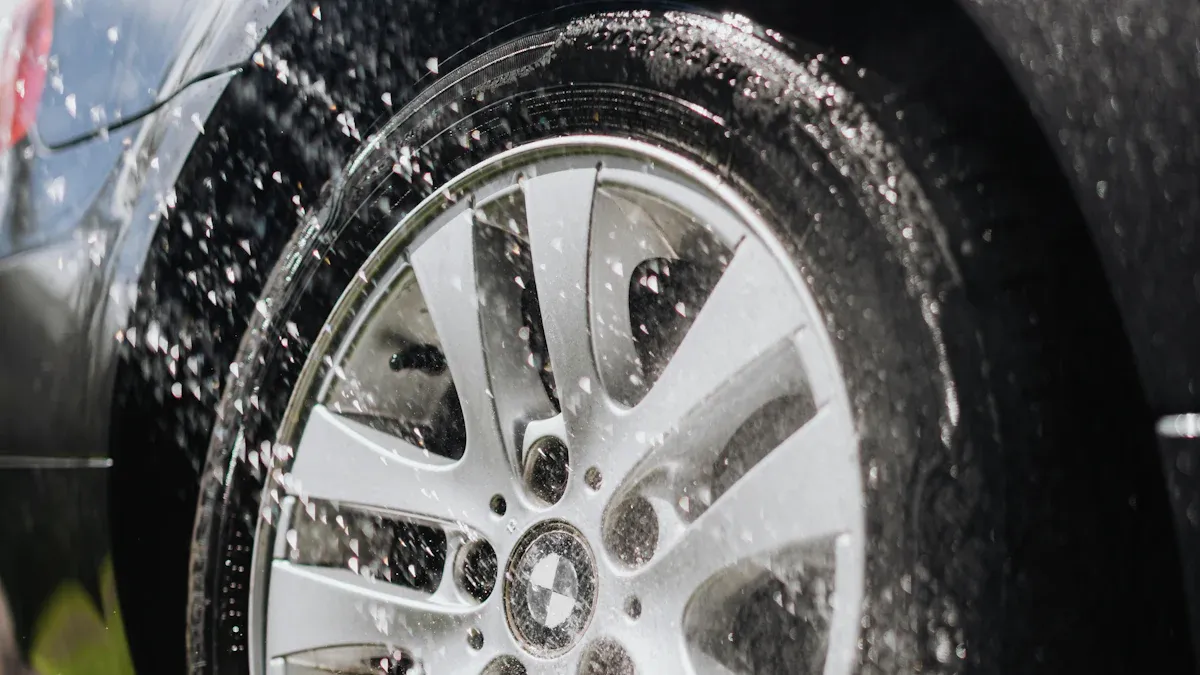
Proper maintenance of a high-performance automatic transmission is essential for ensuring your vehicle operates efficiently and enjoys a longer lifespan. Regular care helps avoid expensive repairs and unexpected breakdowns. Failing to maintain this system can put additional stress on other parts, such as the engine harmonic balancer or the suspension control arm bushing. Additionally, neglect can lead to more frequent issues, like the need for welding cast iron exhaust manifold cracks.
Understanding High-Performance Automatic Transmissions

Key Components
A high-performance automatic transmission relies on several critical components to function effectively. These include the torque converter, planetary gear sets, hydraulic system, and transmission control module (TCM). The torque converter connects the engine to the transmission, allowing your vehicle to shift gears smoothly. Planetary gear sets manage the gear ratios, enabling efficient power delivery. The hydraulic system uses transmission fluid to control gear shifts and lubricate moving parts. Lastly, the TCM acts as the brain of the system, ensuring precise timing and coordination of gear changes.
How They Work
Your high-performance automatic transmission operates by transferring power from the engine to the wheels through a series of gear changes. When you accelerate, the torque converter adjusts the power flow, and the planetary gear sets engage to provide the appropriate gear ratio. The hydraulic system ensures smooth transitions between gears by applying pressure to specific components. Meanwhile, the TCM monitors speed, throttle position, and other factors to optimize performance. This seamless process allows your vehicle to deliver power efficiently while maintaining a comfortable driving experience.
Importance of Maintenance
Proper maintenance is essential to keep your high-performance automatic transmission running smoothly. Regular care prevents wear and tear on key components, ensuring they function as intended. Neglecting maintenance can lead to overheating, fluid contamination, or mechanical failure. By staying proactive, you can extend the lifespan of your transmission and avoid costly repairs. Simple actions, like checking fluid levels and scheduling inspections, go a long way in preserving your vehicle’s performance.
Essential Maintenance Tips for Longevity
Checking and Changing Transmission Fluid
Transmission fluid plays a vital role in keeping your high performance automatic transmission running smoothly. You should check the fluid level regularly, especially if you notice unusual noises or delayed gear shifts. Use the dipstick to inspect the fluid. If it appears dark or smells burnt, it’s time for a change. Fresh transmission fluid ensures proper lubrication and prevents overheating. Most manufacturers recommend changing the fluid every 30,000 to 60,000 miles, but always refer to your vehicle’s manual for specific guidelines.
Using the Correct Fluid
Not all transmission fluids are the same. Using the wrong type can damage your transmission. Always consult your owner’s manual to identify the correct fluid for your vehicle. High performance automatic transmissions often require specialized fluids designed to handle higher temperatures and stress. Using the right fluid improves efficiency and extends the life of your transmission.
Regular Inspections
Routine inspections help you catch potential issues early. Check for leaks under your vehicle and inspect the transmission pan for debris. A professional mechanic can also assess the condition of internal components during scheduled maintenance. Regular inspections save you from costly repairs down the road.
Keeping the System Clean
Dirt and debris can clog your transmission system, leading to poor performance. Replace the transmission filter as recommended by your vehicle’s manufacturer. A clean system ensures smooth gear shifts and reduces wear on internal parts.
Servicing the Cooling System
Your transmission relies on the cooling system to prevent overheating. Ensure the radiator and cooling lines are in good condition. Flush the coolant periodically to maintain optimal performance. Overheating is one of the leading causes of transmission failure, so keeping the cooling system in top shape is essential.
Driving Habits to Protect Your Transmission
Smooth Acceleration and Braking
Aggressive driving can strain your transmission. When you accelerate too quickly, the system works harder to shift gears, which increases wear. Instead, press the gas pedal gently to allow smooth gear changes. Similarly, avoid slamming on the brakes. Sudden stops force the transmission to downshift abruptly, which can cause unnecessary stress. Practicing smooth acceleration and braking not only protects your transmission but also improves fuel efficiency.
Avoiding Overloading
Carrying excessive weight puts extra pressure on your transmission. Overloading forces the system to work harder to transfer power, which can lead to overheating or premature failure. Always check your vehicle’s weight limits in the owner’s manual. If you frequently tow heavy loads, consider installing an auxiliary transmission cooler to help manage the heat.
Proper Gear Usage
Using the correct gear for your driving conditions is essential. For example, avoid shifting into “Park” before your vehicle comes to a complete stop. Doing so can damage the parking pawl inside the transmission. When driving downhill, use lower gears to reduce strain on the brakes and transmission. Always engage the parking brake when parked on an incline to prevent unnecessary stress on the system.
Warming Up Your Vehicle in Cold Weather
Cold weather can thicken transmission fluid, making it harder for the system to function efficiently. Before driving, let your vehicle idle for a few minutes to allow the fluid to warm up. This simple habit ensures smoother gear shifts and reduces wear on internal components. If you live in a colder climate, consider using a block heater to keep your engine and transmission in optimal condition.
Recognizing Warning Signs of Transmission Issues
Unusual Noises or Vibrations
Pay attention to any strange noises or vibrations while driving. A high-performance automatic transmission should operate smoothly and quietly. If you hear grinding, whining, or buzzing sounds, it could indicate worn-out components or low transmission fluid. Vibrations during gear shifts might signal internal damage.
Tip: Test your vehicle on a quiet road to identify unusual sounds. Early detection can save you from costly repairs.
Delayed Gear Shifts or Slipping
Your transmission should shift gears seamlessly. If you notice delays when shifting or feel the gears slipping, it’s a red flag. Slipping occurs when the transmission struggles to stay in the correct gear, often causing a loss of power. This issue might result from worn clutches, low fluid levels, or a failing torque converter.
Warning: Ignoring these signs can lead to complete transmission failure. Address the problem immediately.
Leaking Fluid
Transmission fluid leaks are easy to spot. Look for red or brown puddles under your vehicle. Leaks often occur due to damaged seals, gaskets, or transmission lines. Low fluid levels can cause overheating and damage internal components.
- What to do if you spot a leak:
- Check the fluid level using the dipstick.
- Schedule a repair to fix the source of the leak.
Dashboard Warning Lights
Modern vehicles include sensors that monitor transmission performance. If the transmission warning light illuminates on your dashboard, don’t ignore it. This light often indicates overheating, low fluid levels, or internal issues.
Note: Use an OBD-II scanner to read the error codes or visit a professional mechanic for a diagnosis.
DIY vs. Professional Maintenance
Tasks You Can Handle at Home
You can perform several basic maintenance tasks at home to keep your transmission in good shape. Checking the transmission fluid level is one of the simplest. Use the dipstick to ensure the fluid is at the correct level and inspect its color and smell. Replacing the transmission filter is another task you can handle if you follow the instructions in your vehicle’s manual. Cleaning the area around the transmission pan and inspecting for leaks are also manageable at home.
Tip: Always use the correct tools and follow safety precautions when working on your vehicle. A clean workspace reduces the risk of contamination.
When to Seek Professional Help
Some transmission issues require specialized tools and expertise. If you notice slipping gears, delayed shifts, or dashboard warning lights, it’s time to consult a professional. Diagnosing internal problems, such as worn clutches or a failing torque converter, often involves advanced equipment. Professionals can also perform a complete transmission flush, which ensures all old fluid and debris are removed.
Warning: Attempting complex repairs without proper knowledge can worsen the problem and lead to costly damage.
Advantages of Professional Services
Professional mechanics bring experience and specialized tools to the table. They can accurately diagnose issues and provide long-term solutions. Many shops offer warranties on their work, giving you peace of mind. Professionals also stay updated on the latest technology, ensuring your high-performance transmission receives the best care.
Note: Investing in professional services can save you money in the long run by preventing major repairs or replacements.
Maintaining your high-performance automatic transmission ensures your vehicle runs efficiently and lasts longer. Regular maintenance and good driving habits reduce wear and prevent costly repairs.
- Key Takeaways:
- Check fluid levels and inspect for leaks.
- Drive smoothly and avoid overloading.
Tip: Address warning signs early and consult professionals for complex issues. Proactive care saves money and keeps your transmission in top condition.
FAQ
What happens if you use the wrong transmission fluid?
Using the wrong fluid can damage your transmission. It may cause improper lubrication, overheating, or gear slippage. Always check your owner’s manual for the correct type.
Tip: Stick to manufacturer-recommended fluids to avoid costly repairs.
How often should you change transmission fluid?
Change your transmission fluid every 30,000 to 60,000 miles. Refer to your vehicle’s manual for specific intervals. Regular changes prevent overheating and ensure smooth gear shifts.
Can you drive with a slipping transmission?
Driving with a slipping transmission risks further damage. It reduces power delivery and may lead to complete failure. Address the issue immediately to avoid expensive repairs.
Warning: Ignoring slipping gears can result in unsafe driving conditions.
Post time: Feb-24-2025



